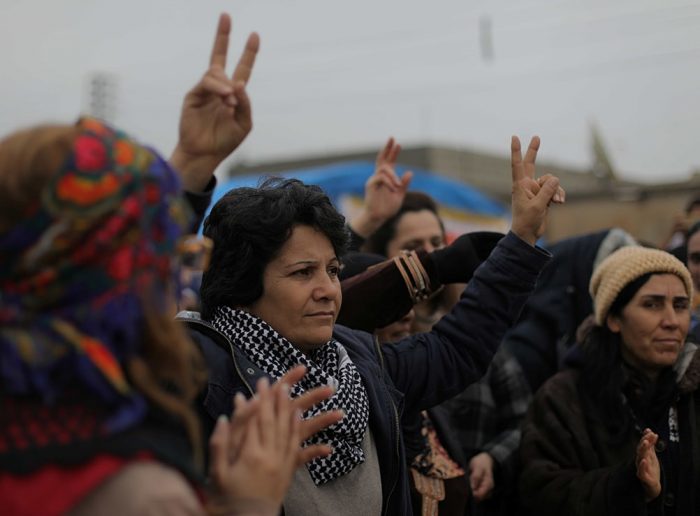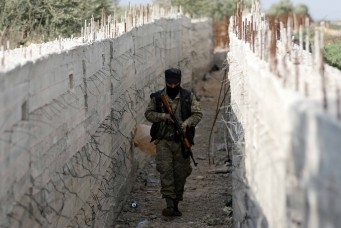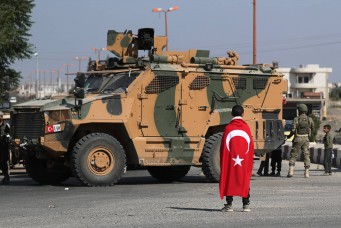Preserving Kurdish Autonomy
Divisions among the states vested in Syria are opening possibilities for Syria’s Kurds to secure greater protection for their autonomy.

A woman gestures during a protest near the Syrian-Turkish border in Ras al-Ayn town, Syria, a part of northern Syria controlled by the pro-Kurdish People’s Protection Units (YPG), December 20, 2018. Rodi Said/Reuters
Syria’s Kurdish forces have had an inauspicious start to 2019. Strained relations between Turkey and their ally, the United States, are once again reshuffling regional alliances. Although there were small signs of rapprochement between Ankara and Washington in late 2018, these disappeared by the second week of January, bringing about a new round of tensions. In this chessboard of regional power shifts, Syrian Kurdish forces are scrambling to protect their hard-won gains.
In December, Turkish President Recep Tayyip Erdoğan convinced U.S. President Donald Trump to withdraw troops from the country by arguing that since the Islamic State (IS) was now defeated, there was no reason to remain. Trump’s decision, made against the advice of his national security team, sent shock-waves throughout the region. Three weeks later, the administration clarified its position to Arab partners, stating that there would be no immediate withdrawal and renewing its vows to protect Kurdish forces in Syria. In response, Turkish Foreign Minister Mevlüt Çavuşoğlu adamantly stated that Turkey’s military was determined to act against the Kurdish fighters of the People’s Protection Units (YPG) as part of the country’s “anti-terror commitment” in eastern Syria, where there is a risk of confrontation with U.S.-backed forces. A new round of negotiations between the United States and Turkey began on January 14 to prepare the conditions for an eventual withdrawal.
Outside powers have historically used the Kurds as pawns in the region to secure their national interests and foreign policy objectives. Cooperation between Turkey, Syria, and Iran was often sustained by their common efforts to thwart claims to Kurdish independence within their respective borders. After the Syrian conflict broke out, Kurds were able to negotiate an autonomous existence within the Syrian state with U.S. support. In 2016, they established the Democratic Federation of Northern Syria, since renamed the Autonomous Administration of North and East Syria (NES), in the region they have governed since 2012. While the events of the past weeks cast shadows over the future of the federation, the Kurds have been preparing for a U.S. withdrawal since early 2018, when Trump first announced his intentions. Yet divisions among the states vested in Syria open possibilities for Syria’s Kurds to negotiate to protect their autonomy.
Turkey has labeled the Syrian Kurdish Democratic Union Party (PYD) and its military forces, the People’s Protection Units (YPG)—an offshoot of the outlawed Kurdistan Workers’ Party (PKK)—as a terrorist organization. However, the YPG is the predominant group within the Syrian Democratic Forces (SDF), which continues to battle the Islamic State. Thus, during his trip to Ankara on January 8, U.S. National Security Adviser John Bolton warned Turkey against any independent military incursion into eastern Syria without Washington’s consent. Erdoğan responded unequivocally, stating, “Turkey will continue to do what it must to ensure its own safety.” Erdoğan has in fact threatened military action east of the Euphrates River for over a year, not least due to the broad popular support within Turkey for its incursion into Afrin in January 2018. In response, on January 14 Trump promised to “devastate Turkey economically” if it attacks the Kurdish militia. The Kurds could continue to capitalize on tense relations between Turkey and the United States to show their value to the United States as a more reliable ally against remaining pockets of IS resistance.
However, a potential Turkish military incursion eastward also has its detractors within the Turkish Armed Forces, who recognize that the SDF is both better armed and battle hardy than the forces that had defended Afrin. If it intervenes, Turkey also risks facing not only Kurdish forces but potentially also the Syrian state and its allies, Russia and Iran. The U.S. decision to withdraw may stoke populist fervor in Turkey for an intervention, but the fluid situation on the ground may make it preferable as a rhetorical tool only. With local elections in Turkey on March 31, 2019, this rhetoric could rally support for the Justice and Development Party (AKP) among Turkish nationalists, whom the party relies upon to maintain its hold on power. The U.S. administration’s policy reversal and subsequent threats undermine Turkey’s strongman at a particularly sensitive time, as the ongoing economic crisis is threatening the AKP’s electoral support.
Since 2016, Erdoğan has preferred collaborating on Syria with Russian President Vladimir Putin, who acknowledges Turkey’s security concerns and provides it a platform to project power in the region through the Astana process. However, this relationship is also troublesome for Erdoğan, as Turkish nationalists—who are traditionally firmly pro-United States—regard Russia with suspicion. Erdoğan’s ally, Turkey’s Nationalist Movement Party (MHP), is also critical of any collaboration with Bashar al-Assad’s regime in Syria. Thus, Erdoğan’s domestic alliances leading up to the March elections are set to strain his foreign relations.
In the event of a withdrawal, the Kurds need to consider alternatives that will secure their own gains. Putin, who has long aimed to bring the Kurdish forces closer to the Assad regime, has reiterated the need for talks between Assad and the PYD, since territory controlled by the United States is due to be returned to the Syrian state. If the Kurds are unwilling to compromise with Assad, they are likely to face persistent Turkish threats. However, Syrian state control in the Kurdish regions would make future Turkish interventions more costly. And as Russia has already illustrated in Afrin, where it evacuated its military advisers and allowed Turkey airspace access to enable the “Olive Branch” offensive, it is willing to sacrifice the Kurds to maintain its relationship with Turkey. Arguably, Russia’s primary interests in Syria have been to capitalize on Turkish-U.S. discord to weaken NATO, the United States, and its regional allies while promoting itself as kingmaker. The Kurds have served as leverage for Moscow to reach compromises in the pursuit of its goals. When the United States pulls out, it remains on Russia to secure an acceptable end to the war before withdrawing.
Adding to the complexity, the Gulf Arab states are primarily concerned with preventing Iran from growing its regional influence. Syria has been Iran’s ally since the 1979 Iranian Revolution, and once the uprising started in 2011, Iran proved its loyalty to the regime by sending money, arms, and military advisers to support Assad. Saudi Arabia and Turkey put aside their differences in 2015 to support a coalition of jihadi groups under the umbrella of Jaysh al-Fatah, which opposed Iran and defied U.S. policy. However, according to Turkish media, over the past year Saudi Arabia has been courting the YPG, sending them aid and offering to pay them to join Arab-backed forces. In August 2018, Saudi Arabia committed to transferring $100 million through the United States “for American efforts to stabilize areas in Syria liberated from Daesh”—in essence, areas under YPG control. These already deteriorating relations between Saudi Arabia and Turkey worsened after the fallout from Jamal Khashoggi’s murder in October. Support for the Kurds allows Saudi Arabia and its allies to frustrate Turkish efforts to isolate and defeat the YPG, but also helps to counter Iran—whose own influence in the Levant would diminish if the Syrian regime’s did. However, for Iran, maintaining its foothold in Syria represents more than just a geopolitical advantage. It is a “securitized” issue critical to the existence of the Iranian state. For Tehran, a stable Syria under Assad where it can wield influence both acts as a deterrent against Israel and maintains the regional balance of power against Sunni actors.
Despite the different agendas involved, the SDF finds itself in a historically stronger position to influence outcomes. Given the vacillations in U.S. policy, Russia’s betrayal, and Turkish aggression, Kurdish forces might find themselves forced to collaborate with the Syrian state. Discussions between the SDF and the Assad regime, already begun in May 2018, are tackling the issues of the constitution and negotiating over a final settlement. Working with the regime, which has historically denied Kurds citizenship rights and opposed the federalist project, will be challenging, as Assad has insisted in earlier negotiations that Syrian Kurds accept a re-imposition of Syrian state control.
However, the SDF has since accumulated leverage: It governs the largest swathe of territory outside Syrian state control, a territory rich in agricultural resources and oil. The Syrian Kurdish militias also have potential Gulf state benefactors keen to gain geopolitical advantage. Furthermore, the SDF manages Iranian interests in the areas under Kurdish control. In spite of their preference for Syrian central control, Iran recognizes that a disgruntled SDF would turn toward rival regimes for support and therefore must have some of their demands met. Thus, the SDF will go into negotiations from a position of strength, making it difficult for the Syrian regime to dictate the terms of a settlement for northeastern Syria.
As in a game of chess, working with the Assad regime may be a positional sacrifice that later serves to secure a longer-term advantage. Whereas before, regional powers collaborated on a “divide and rule” policy against Kurdish aspirations, Syria’s Kurds now “divide and balance” regional powers. Yet the U.S. withdrawal risks creating a power vacuum in which remaining powers scramble to take advantage. For Kurds to reach their goal of autonomy within a federal Syria, they must carefully negotiate the moves, strategies, and possible sacrifices along the way.
Pinar Tank is a senior researcher at the Peace Research Institute Oslo (PRIO). Follow her on Twitter @PinarTank1.





